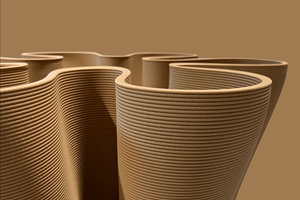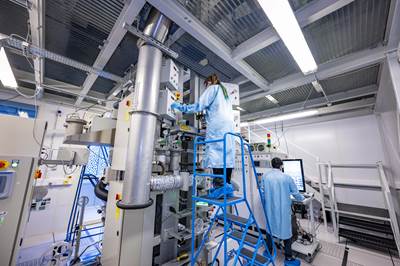MORPHO advances structural prognostics, health monitoring and composites manufacturing efficiencies
EU project concluded in January 2025, delivering on its goals to enhance aerospace industry performance and sustainability through real-time monitoring, intelligent control systems and innovative recycling techniques.
Share
MORPHO team at their final conference in Vigo, Spain. Source | MORPHO
The EU-funded project, which began in April 2021, officially concluded in January 2025, successfully delivering advancements in structural prognostics and health monitoring (SPHM), manufacturing optimization and composite materials recycling. Leveraging of real-time monitoring, intelligent control systems and innovative recycling techniques enabled MORPHO’s consortia to redefine how industries approach structural integrity, production efficiency and environmental responsibility.
At the heart of these achievements lies the development of smart aeronautical components with embedded life cycle management systems. The innovations are reported to integrate advanced sensing technologies for real-time monitoring and address end-of-life (EOL) sustainability challenges, supporting global efforts to improve resource efficiency and reduce environmental impacts.
“The integration of Fiber Bragg Grating [FBG] sensors and printed piezoelectric transducers with innovative recycling techniques is a major step forward for aerospace manufacturing,” says Nazih Mechbal of the Arts et Métiers Institute of Technology and MORPHO project coordinator. “This work ensures not only improved performance and monitoring during operation but also a sustainable pathway for material recovery and reuse.”
SPHM framework for aerospace components
The MORPHO project introduced a novel, AI-based SPHM framework specifically targeting engine components such as fan blades. This approach integrates low-frequency fatigue testing, advanced sensing techniques and a deep learning architectures to predict stiffness degradation and remaining useful life (RUL) base don strain and guided waves data.
A case study involving a foreign object damage (FOD) panel subjected to cyclic loading is reported to have demonstrated remarkable accuracy. For stiffness reduction, the average metrics across all folds included a mean squared error (MSE) of 8.63, a root mean squared error (RMSE) of 2.58 and a mean absolute percentage error (MAPE) of 1.87%. Meanwhile, RUL estimation metrics achieved an MSE of 4192.3, an RMSE of 63.41 and a MAPE of 14.57%, considering an EOL with 1% global stiffness reduction of the FOD panels.
These advancements pave the way for a condition-based maintenance paradigm of aerospace components by enabling near real-time assessment of structural integrity.
Intelligent RTM process optimization
The MORPHO project also advanced resin transfer molding (RTM) for carbon fiber-reinforced polymers (CFRP). Through the use of dielectric sensors and real-time data analytics, the team successfully achieved a 20% reduction in cure cycle times, equating to a 50-minute acceleration for standard cycles. This was made possible through the development of robust, durable sensors capable of monitoring resin arrival, viscosity and curing under industrial conditions.
Complementing this, an online software system provided precise real-time monitoring of viscosity and glass transition temperature (Tg), enabling optimized cycle validation. These cycles integrated real-time data to enhance both efficiency and part quality.
Sensor technology and real-time monitoring
FBG sensors and printed piezoelectric transducers, embedded in engine components like FOD panels, demonstrated their ability to monitor strain, stress and damage in real time during manufacturing and operation. These sensors enabled precise resin flow monitoring during RTM, facilitated structural health monitoring (SHM) for long-term component integrity and were integrated without compromising structural strength, underscoring their industrial viability. Printed piezoelectric and temperature sensors exhibited potential for broader applications, including the detection of impact damage and the monitoring of temperature changes in otherwise inaccessible areas.
Sustainability through recycling and laser-shock disassembly
MORPHO also advanced sustainable manufacturing by developing laser-shock disassembly and pyrolysis techniques for recycling CFRP materials. These efforts resulted in the recovery of carbon fibers with less than 10% degradation in mechanical properties and the successful scaling of recovery processes to near-industrial levels. These achievements highlight the project’s commitment to environmental stewardship while addressing the challenges associated with composite material production.
The hybrid twin: Real-time simulation and manufacturing insights
One of the most advanced innovations of the MORPHO project is its hybrid twin for the RTM process, which seamlessly combines high-fidelity physics-based simulations with real-time data. This system has demonstrated optimal capabilities, including achieving highly accurate predictions of resin flow and curing with an MSE of less than 1% in under 1 millisecond. Additionally, the hybrid twin technology enables real-time identification of local permeabilities in woven preforms, significantly enhancing quality control during production. By integrating this sophisticated approach, MORPHO enables precise, data-driven adjustments throughout the manufacturing process, boosting productivity, improving component quality and reducing waste.
Related Content
Combining multifunctional thermoplastic composites, additive manufacturing for next-gen airframe structures
The DOMMINIO project combines AFP with 3D printed gyroid cores, embedded SHM sensors and smart materials for induction-driven disassembly of parts at end of life.
Read MoreSulapac introduces Sulapac Flow 1.7 to replace PLA, ABS and PP in FDM, FGF
Available as filament and granules for extrusion, new wood composite matches properties yet is compostable, eliminates microplastics and reduces carbon footprint.
Read MoreThe potential for thermoplastic composite nacelles
Collins Aerospace draws on global team, decades of experience to demonstrate large, curved AFP and welded structures for the next generation of aircraft.
Read MoreLow-cost, efficient CFRP anisogrid lattice structures
CIRA uses patented parallel winding, dry fiber, silicone tooling and resin infusion to cut labor for lightweight, heavily loaded space applications.
Read MoreRead Next
U.K. academics head up flat fiber sensor research for composites
Six universities are in charge of developing flat fiber sensors, which will then be applied with industry partners, to determine their impact in monitoring composites manufacturing and more.
Read MoreSAM XL demonstrates closed-loop digital methodologies via full-size aerocomposite parts development
PeneloPe Project’s modular, zero-defect manufacturing deliverables are being highlighted in an upcoming video that demonstrates the resulting aerospace pilot line’s feasibility.
Read MoreBIOntier project studies multi-sector biocomposites development
Thirty-six month project will develop, demonstrate,and validate the efficacy of bio-based composite products, which will underlie future technologies for automotive, aerospace, hydrogen and water treatment.
Read More









